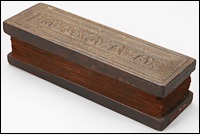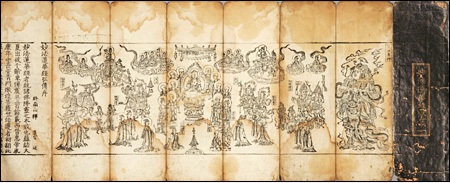Exhibition marks 1,000th anniversary of the First Edition of Tripitaka
.jpg) Daebanggwangbul-hwaeomgyeong Tripitaka — Korean cultural heritage
Daebanggwangbul-hwaeomgyeong Tripitaka — Korean cultural heritageThis year marks the 1,000th year of the engraving «Chojo Daejanggyeong» (the First Edition of the Tripitaka Koreana), on which work was begun in 1011, during the second year of the reign of King Hyeonjong, and completed in 1087 in the Goryeo Kingdom (918-1392).
To commemorate the occasion, the Horim Museum is holding a special exhibition to display some 100 printed papers of the woodblocks and related items, including four national treasures at its Sinsa and Sillim branches.
The exhibition shows the essence of Buddhist culture and its printing technology of Goryeo through the early Tripitaka.
Tripitaka refers to a collection of Buddhist sutras known as the records of Buddha’s teachings. It was the second Tripitaka translated into Chinese characters in the world and it retains historical value as it includes a vast amount of content as the longest Chinese-language scriptures.
Chojo Daejanggyeong is the first Tripitaka in Korea, which was made to repel the Khitan invaders in the 11th century. It was stored in Heungwang Temple and moved to Buin Temple. Only the printed papers exist as the woodblocks were destroyed by Mongolian troops in 1232.
Palman Daejanggyeong (Tripitaka Koreana) stored in Haein Temple and designated as a UNESCO’s Memory of the World was manufactured after Chojo Daejanggyeong had been lost.
Joseon’s calligrapher Chusa Kim Jeong-hee once highly praised Chojo Daejanggyeong, which means it has more historical value than Palman Daejanggyeong in terms of calligraphy and engraving skills, saying «Its calligraphy is not man’s writing but God’s».
The exhibitions at the two branches are basically the same, displaying the wood prints of the Chojo Daejanggyeong.
 Tibetan Tripitaka
Tibetan Tripitaka
But the Sillim branch features Goryeo relics such as celadon and paintings, while the Sinsa branch highlights foreign Tripitakas from Tibet, Japan, China and Laos to show the overall history of the Buddhist culture and art worldwide.
«Tripitaka exemplifies not just the Buddhist culture but high-tech artistry that combines printing and paper-making technology of the period», Park Jun-young, curator of the exhibition, said.
He said that engraving the Tripitaka in a belief to fight a foreign invasion with the strong Buddhist faith relates to the power of the nation at that time.
«It’s more interesting to see how the monks studied through these scriptures because the Chojo Daejanggyeong had some typos although they were corrected in the second edition», he said.
The exhibition also includes handwritten scripts which are more flamboyant and sophisticated than the printed versions and are sometimes adorned with gold powder.
«Saganbon», or a separate book of the scripture collection, which was usually made in a temple is also on view at the exhibition. They include the Buddhist paintings unlike other scriptures to help ordinary people better visually understand the abstruse contents of the Buddhist sutra.
 Lotus sutra including a Buddhist painting
Lotus sutra including a Buddhist paintingThe artistry of the paintings developed as the demands of the Buddhist sutra rose along with the advancement of printing technology. A variety of architecture and attire styles described in the paintings tell the social and cultural aspects of the Goryeo era.
Visitors can also appreciate the Goryeo people’s views on beauty through the Buddhist world going beyond the time and space reflected in the paintings. The paintings based on the Buddhist teachings offer an opportunity for visitors to get a glimpse of the Buddhist art and printing culture of that time.
The curator said that visitors can compare the differences between the first and second editions of Tripitaka at the exhibition.
Park said, among other things, the highlight of the exhibition is the quality of paper. The high quality of Goryeo paper enables modern visitors to see a thousand-year-old copies of the Chojo Daejanggyeong as the printed papers have been well preserved.
«This kind of paper can last for 1,000 years and silk can last for 500 years, the excellence of traditional paper is well known», he said.
Particularly, Goryeo’s papers were valued for having the highest quality even in China. There is a record saying «Goryeo papers are strong and white equivalent to silk fabrics and absorb the ink well and thus they are regarded as precious objects that can hardly be found in China.»
«Even though visitors don’t understand the Buddhist teachings described in the Tripitaka, they might admire the quality of the paper that proved to be durable for more than 1,000 years», said the curator. The exhibition also features various paintings, 2,000 classical books, 600 pieces of metal artifacts and 400 other works of art. Among these, 54 are classified as national cultural properties.
The exhibition at the Sinsa branch will continue through Aug. 31 while the Sillim branch’s exhibition will be held until Sept. 30.
Source: The Korea Times



